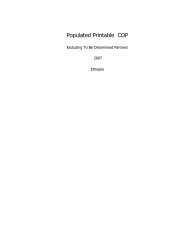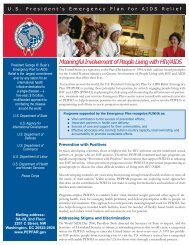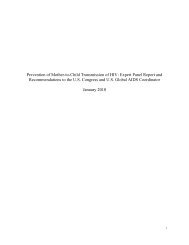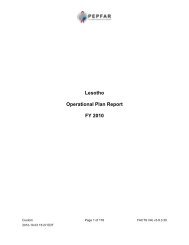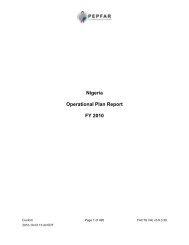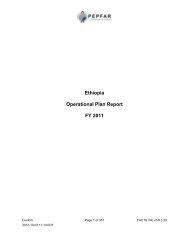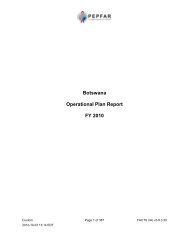Monitoring and Evaluation Systems Strengthening Tool - Pepfar
Monitoring and Evaluation Systems Strengthening Tool - Pepfar
Monitoring and Evaluation Systems Strengthening Tool - Pepfar
Create successful ePaper yourself
Turn your PDF publications into a flip-book with our unique Google optimized e-Paper software.
<strong>Monitoring</strong> <strong>and</strong> <strong>Evaluation</strong><br />
<strong>Systems</strong> <strong>Strengthening</strong> <strong>Tool</strong><br />
January 2007
<strong>Monitoring</strong> <strong>and</strong> <strong>Evaluation</strong><br />
<strong>Systems</strong> <strong>Strengthening</strong> <strong>Tool</strong><br />
January 2007<br />
MS-07-18<br />
Printed on recycled paper
This tool was made possible by support from the U.S. Agency for International Development (USAID)<br />
under terms of Cooperative Agreement GPO-A-00-03-00003-00.<br />
Additional financial support was provided by the President’s Emergency Plan for AIDS Relief <strong>and</strong> the<br />
Global Fund to Fight AIDS, TB <strong>and</strong> Malaria.<br />
The authors’ views expressed in this publication do not necessarily reflect the views of USAID or the<br />
United States Government. This publication can be accessed online at the MEASURE <strong>Evaluation</strong> Web<br />
site: http://www.cpc.unc.edu/measure.
Acknowledgements<br />
This tool was developed with input from a number of people from collaborating organizations.<br />
Those most directly involved in the development of the tool include Ronald Tran Ba Huy of the<br />
Global Fund to Fight AIDS, Tuberculosis <strong>and</strong> Malaria <strong>and</strong> Karen Hardee, J. Win Brown, <strong>and</strong><br />
Ron Stouffer of the MEASURE <strong>Evaluation</strong> Project. Others who were instrumental in the tool<br />
development include Bernhard Schwartländer, Bernard Nahlen, Daniel Low-Beer, <strong>and</strong> Linden<br />
Morrison from the Global Fund to Fight AIDS, Tuberculosis <strong>and</strong> Malaria; Sara Pacque-Margolis,<br />
formerly of the Office of the Global AIDS Coordinator; Kathy Marconi of the Office of the Global<br />
AIDS Coordinator; Philip Setel, Dave Boone, Ani Hyslop, Erin Eckert, <strong>and</strong> Stephanie Mullen<br />
from MEASURE <strong>Evaluation</strong>; John Novak <strong>and</strong> Misun Choi from USAID; Carla Abou Zahr, Norma<br />
Wilson, Ties Boerma, <strong>and</strong> Bob Pond of the Health Metrics Network. The tool greatly benefited<br />
from the participation of a number of people in pilot tests in Rw<strong>and</strong>a, Russia, Chile, Niger, Congo<br />
(Brazzaville), Bangladesh, <strong>and</strong> China.<br />
Acknowledgements
Introduction<br />
1.<br />
Why a M&E <strong>Systems</strong> <strong>Strengthening</strong> <strong>Tool</strong>?<br />
National governments <strong>and</strong> donors are working to fight many diseases, including HIV/AIDS, Tuberculosis <strong>and</strong><br />
Malaria, <strong>and</strong> to make improvements in a number of health areas. As national Programs <strong>and</strong> associated projects<br />
to support these Programs grow, accountability for funding <strong>and</strong> results reported is becoming increasingly<br />
important. These Programs <strong>and</strong> associated projects are setting ambitious goals <strong>and</strong> objectives, the achievement<br />
of which are measured through monitoring <strong>and</strong> evaluation (M&E) indicators, such as the following:<br />
•<br />
•<br />
•<br />
•<br />
•<br />
•<br />
What is the incidence <strong>and</strong> prevalence of the disease?<br />
How many people are on treatment?<br />
How many people in specific populations have been reached by prevention activities?<br />
How many staff have been trained to provide services?<br />
How many commodities have been distributed?<br />
Has there been any behavior change <strong>and</strong> reduced morbidity or mortality?<br />
How confident can national Programs <strong>and</strong> associated projects be in the quality of data available to measure<br />
indicators? Accurately measuring the success of these initiatives <strong>and</strong> improving Program management is<br />
therefore predicated on strong M&E systems that produce quality data.<br />
In the spirit of the M&E component of the “Three Ones,” a number of multilateral <strong>and</strong> bilateral organizations<br />
<strong>and</strong> initiatives have collaborated to develop a tool to assess M&E Plans <strong>and</strong> <strong>Systems</strong> (see Figure 1). The<br />
M&E <strong>Systems</strong> <strong>Strengthening</strong> <strong>Tool</strong> is designed as a generic tool to assess the data collection, reporting <strong>and</strong><br />
management systems to measure indicators of Program <strong>and</strong> project success. Simply put, this tool addresses<br />
primarily the M&E plan <strong>and</strong> systems that need to be in place to collect <strong>and</strong> channel data up a system for<br />
aggregation into relevant indicators for Program management <strong>and</strong> reporting.<br />
Figure 1. Framework.<br />
Introduction
The M&E <strong>Systems</strong> <strong>Strengthening</strong> <strong>Tool</strong> is intended to be compatible with a range of other M&E capacity<br />
assessment <strong>and</strong> improvement tools, including the Health Metrics Network (HMN) Assessment <strong>Tool</strong>, the Building<br />
National HIV/AIDS <strong>Monitoring</strong> <strong>and</strong> <strong>Evaluation</strong> Capacity <strong>Tool</strong>, the Performance of Routine Information<br />
<strong>Systems</strong> Management (Prism) Framework <strong>Tool</strong>s, <strong>and</strong> the National M&E Road Maps, among others.<br />
The M&E <strong>Systems</strong> <strong>Strengthening</strong> <strong>Tool</strong> can be used at the national level, within groups of projects, <strong>and</strong> within<br />
individual projects or organizations that are seeking to assess M&E data collection <strong>and</strong> reporting systems, <strong>and</strong><br />
to implement action plans for strengthening M&E. This tool was pilot-tested early in 2006 by HIV/AIDS, TB<br />
<strong>and</strong> Malaria Programs <strong>and</strong> projects across Africa, China, Latin America, Russia, <strong>and</strong> South Asia.<br />
2.<br />
What are the Objectives of the M&E <strong>Systems</strong> <strong>Strengthening</strong> <strong>Tool</strong>?<br />
The overall objective of the M&E <strong>Systems</strong> <strong>Strengthening</strong> <strong>Tool</strong> is to help national Programs <strong>and</strong> associated<br />
projects improve their M&E <strong>and</strong> the quality of data generated to measure success of implemented activities.<br />
More specifically, the M&E <strong>Systems</strong> <strong>Strengthening</strong> <strong>Tool</strong> has been designed to:<br />
1.<br />
2.<br />
3.<br />
Assess the M&E Plan <strong>and</strong> capacities of the Program’s/project’s implementing entities;<br />
Evaluate how the M&E activities of Programs/projects are linked <strong>and</strong> integrated within the National<br />
M&E System;<br />
Help to develop a costed action plan to strengthen M&E systems.<br />
This M&E <strong>Systems</strong> <strong>Strengthening</strong> <strong>Tool</strong> can help all reporting entities under government Programs <strong>and</strong><br />
donor-projects assess the strengths <strong>and</strong> weaknesses of their M&E systems, including data collection <strong>and</strong><br />
reporting, <strong>and</strong> highlighting areas for improvement that might require additional focus, funds <strong>and</strong>/or technical<br />
assistance. The outcome of the assessment should be an action plan to enable the appropriate follow-up<br />
measures to strengthen M&E.<br />
The completion of the M&E <strong>Systems</strong> <strong>Strengthening</strong> <strong>Tool</strong> <strong>and</strong> the development of an action plan should:<br />
◊<br />
◊<br />
◊<br />
◊<br />
Help identify M&E capacity gaps <strong>and</strong> corresponding strengthening measures, including through technical<br />
assistance (TA);<br />
Guide investments in M&E (to better inform the development of a M&E budget);<br />
Ensure that such investments contribute to the strengthening of the national systems (avoiding parallel<br />
reporting systems);<br />
Improve the quality of programmatic data to enhance planning <strong>and</strong> Program management.<br />
Because the M&E <strong>Systems</strong> <strong>Strengthening</strong> <strong>Tool</strong> is designed to promote alignment behind the M&E strategies<br />
<strong>and</strong> plans for the health sector overall, as well as those for specific disease control Programs, the country’s<br />
health information system should be the main source of information for M&E, <strong>and</strong> interventions to strengthen<br />
project-related M&E should build upon <strong>and</strong> reinforce that overall system. It is therefore recommended that<br />
a broader group of stakeholders be engaged in the self-assessment, rather than just those responsible for<br />
specific projects or Programs (although the self-assessment can be used internally within an organization to<br />
assess its own M&E system related to data collection <strong>and</strong> indicator measurement). Key stakeholders include,<br />
among others, representatives of the Central Statistics Office as well as those responsible for the overall health<br />
information system of the Ministry of Health.<br />
<br />
M&E <strong>Systems</strong> <strong>Strengthening</strong> <strong>Tool</strong>
It is also important that the M&E <strong>Systems</strong> <strong>Strengthening</strong> <strong>Tool</strong> be used in the context of other efforts being<br />
undertaken to strengthen M&E systems at the country level, particularly efforts coordinated among a number<br />
of stakeholders <strong>and</strong> partners, such as a funded M&E Roadmap. Use of the M&E <strong>Systems</strong> <strong>Strengthening</strong><br />
<strong>Tool</strong> is not intended to be a st<strong>and</strong>-alone activity. This tool can help these efforts through diagnosis of gaps in<br />
the M&E system as it relates to collecting, reporting <strong>and</strong> managing data reported on diseases <strong>and</strong> health issues.<br />
If strengthening efforts are already underway, the tool can help assess the progress of these efforts.<br />
3.<br />
What is the Content of the M&E <strong>Systems</strong> <strong>Strengthening</strong> <strong>Tool</strong>?<br />
The M&E <strong>Systems</strong> <strong>Strengthening</strong> <strong>Tool</strong> comprises three complementary Checklists (see Figure 2) designed<br />
to comprehensively assess both the Program <strong>and</strong> projects’ abilities to collect, analyze, use <strong>and</strong> report accurate,<br />
valuable <strong>and</strong> high-quality M&E data. Programs or projects using the Checklists for self-assessment purposes<br />
should use the Excel files containing the three Checklists.<br />
Figure 2. Three Checklists.<br />
Introduction
1.<br />
2.<br />
3.<br />
Assessing the M&E Plan<br />
This Checklist looks at the goals <strong>and</strong> objectives of Programs <strong>and</strong> projects <strong>and</strong> how they relate to a<br />
country’s national strategy <strong>and</strong> M&E Plan, if they exist. The Checklist assesses, for national Programs<br />
<strong>and</strong> donor-funded projects, the indicators selected, their data sources, target-setting, <strong>and</strong> availability of<br />
baselines. Special attention is given to identifying whether parallel reporting systems are being set up<br />
for donor-funded projects (i.e., outside the national reporting system). The Checklist also looks at data<br />
dissemination <strong>and</strong> transparency, as well as the confidentiality of sensitive data. Finally, the Checklist<br />
assesses the budget amount allocated to M&E.<br />
Assessing Data Management Capacities of the Program/Projects’ Management Units<br />
This Checklist assesses the data management systems of the management units of national Programs or<br />
donor-funded projects. The Checklist seeks to determine if the management units possess the resources,<br />
procedures, skills, <strong>and</strong> experience necessary for M&E data management <strong>and</strong> reporting. The Checklist<br />
also assesses whether the management units provide sufficient oversight, guidance, <strong>and</strong> support to subreporting<br />
entities, <strong>and</strong> if feedback is provided to them on the quality of their reporting <strong>and</strong> on Program<br />
performance.<br />
Assessing Data Reporting <strong>Systems</strong> per Program Area<br />
This Checklist assesses the strengths of Programs’ <strong>and</strong> projects’ data-collection <strong>and</strong> reporting systems per<br />
Program area, including the ability to report valid, accurate, <strong>and</strong> high-quality data related to implementation.<br />
Most Program areas associated with the delivery of services or commodities can be grouped depending<br />
on whether they are implemented in a health facility or in the community. Some other Program areas,<br />
such as laboratory support, relate to systems strengthening. Therefore, this Checklist includes three<br />
questionnaires—one for health facility-based activities (e.g., ARV, PMTCT), one for community-based<br />
activities (e.g., BCC for TB), <strong>and</strong> one for systems strengthening activities (e.g. laboratory support). Within<br />
these three questionnaires, the Checklist focuses on data reporting systems that produce numbers related<br />
to: (1) people reached/served; (2) commodities distributed; (3) people trained; <strong>and</strong> (4) service points/<br />
facilities/organizations supported.<br />
Each Checklist contains (1) a list of questions to perform the diagnosis, <strong>and</strong> (2) a template for developing<br />
a costed action plan for strengthening M&E systems. The Checklists are contained in Microsoft Excel<br />
spreadsheets, which include instructions on how to complete the Checklists <strong>and</strong> which stakeholders should<br />
be involved.<br />
Comments on the M&E <strong>Systems</strong> <strong>Strengthening</strong> <strong>Tool</strong> <strong>and</strong> descriptions of experiences with its use would be<br />
welcomed by the development team <strong>and</strong> should be sent to the Data Quality Team at MEASURE <strong>Evaluation</strong>.<br />
<br />
M&E <strong>Systems</strong> <strong>Strengthening</strong> <strong>Tool</strong>
GLOSSARY<br />
AIS<br />
AIDS Indicators Survey<br />
ARV<br />
Antiretroviral<br />
BSS<br />
Behavior Surveillance Survey<br />
DHS<br />
Demographic <strong>and</strong> Health Surveys<br />
HIS<br />
National Health Information System<br />
ID<br />
Identification<br />
M&E<br />
<strong>Monitoring</strong> <strong>and</strong> <strong>Evaluation</strong><br />
Management Unit<br />
Organization ultimately responsible for the Program or the projects (such as a Central<br />
Coordinating Office for the National Program, the Principal Recipient for the Global<br />
Fund, or the Prime Partners for the Emergency Plan – PEPFAR).<br />
MICS<br />
Multi Indicator Cluster Surveys<br />
MOH<br />
Ministry of Health<br />
PEPFAR<br />
U.S. President’s Emergency Plan for AIDS Relief<br />
PMTCT<br />
Prevention of Mother-to-Child Transmission<br />
Program-level Indicators<br />
These are the indicators that enable to track progress in the implementation of Programs<br />
or projects. These indicators are generally grouped in four categories:<br />
1- Number of People Reached, 2- Number of Commodities Distributed, 3- Number of<br />
Individuals Trained, <strong>and</strong> 4- Number of Service Points/Facilities/Organizations Supported.<br />
SAM<br />
Service Availability Mapping<br />
SI<br />
Strategic Information<br />
SPA<br />
Service Provision Assessment<br />
Sub-Reporting Entities<br />
All organizations involved in the Program or the projects which report programmatic<br />
data to the Management Unit.<br />
UNAIDS<br />
United Nations Joint Programme on AIDS<br />
Glossary
M&E <strong>Systems</strong> <strong>Strengthening</strong> <strong>Tool</strong><br />
Checklist to Assess Program/Projects M&E Plan<br />
Note: Other checklists that are part of this M&E <strong>Systems</strong> <strong>Strengthening</strong> <strong>Tool</strong> include:<br />
• Assessing the Data Management Capacities of the Management Unit; <strong>and</strong><br />
• Assessing the Data Reporting <strong>Systems</strong> per Program Area.
A – INSTRUCTIONS – M&E PLAN<br />
OBJECTIVE<br />
To assess the strength of the <strong>Monitoring</strong> <strong>and</strong> <strong>Evaluation</strong> (M&E) plan related to a Program, project or group of projects.<br />
CONTENT<br />
This Checklist has five sections:<br />
1- National Strategy <strong>and</strong> National M&E Plan<br />
Is there a National Strategy related to the relevant health or disease area addressed by the Program or project(s)? Is there<br />
a National M&E Plan linked to the National Strategy?<br />
2- Goals <strong>and</strong> Objectives of the Program/Project(s)<br />
Are the goals <strong>and</strong> objectives of the Program or project(s) in line with the National Strategy <strong>and</strong> are they time bound <strong>and</strong><br />
measurable?<br />
3- M&E Indicators in the Program/Project(s)<br />
Do indicators have clear definitions, data sources with baselines <strong>and</strong> targets? Were indicators selected in collaboration<br />
with national/international M&E partners? Is indicator data linked with the National M&E system?<br />
4- Data Dissemination <strong>and</strong> Transparency<br />
Will data from the Program or project(s) be disseminated properly <strong>and</strong> will sensitive data remain confidential?<br />
5- M&E Budget<br />
Has the Program or project allocated sufficient financial resources for M&E?<br />
COMPLETING THE CHECKLIST<br />
Save the Checklist files before use. The Checklist files should be saved with a name that will help to easily identify the<br />
country/disease/date of completion.<br />
This Checklist has been designed to be flexible in terms of use by National Programs, single projects or groups of<br />
projects (e.g., a group of Global Fund grants). If the Checklist is being used for a group of projects, it should first be<br />
completed by each project <strong>and</strong> then a consolidated version should be filled out collectively by the projects.<br />
At the top of the Checklist is a row to specify which M&E plan is being assessed through the Checklist. For example,<br />
if the National Program is completing the Checklist, the National M&E Plan would be specified. Similarly, if the M&E<br />
plan relates to a donor-funded project, that M&E plan would be specified. If the M&E plans of a group of projects is being<br />
consolidated in the assessment, that should also be specified.<br />
The Checklist has been designed as a series of statements to which respondents answer Yes-completely, Mostly, Partly<br />
or No-not at all. For example, the statement could be: “The frequency of data collection is stated for all indicators.” If<br />
such frequency is stated for most, but not all, indicators, the answer should be Mostly. In cases in which the statement is not<br />
applicable, respondents should select the answer category N/A.<br />
Checklist to Assess Program/Projects M&E Plan<br />
13
Some statements in the Checklist may not be relevant to National Programs. These statements have been identified on<br />
the Checklist as [not applicable to the National Program]. In these cases, the National Program can skip the statement or<br />
answer N/A in the ANSWER box.<br />
In the Excel file, the appropriate answer should be selected through the “drop-down box” in the ANSWER column.<br />
The Yes-completely responses will appear in green, Mostly <strong>and</strong> Partly will appear in yellow, <strong>and</strong> No-not at all will appear in<br />
red.<br />
For all answers, respondents should provide an explanation in the COMMENT box (by typing directly in the<br />
COMMENT box in the Excel file). Using the COMMENT box will increase the usefulness of this Checklist for purposes of<br />
improving a Program or project’s M&E.<br />
The Checklist contains a column for REVIEW AND VERIFICATION COMMENTS. This column is to be used if the<br />
Checklist is reviewed by a “third party,” such as the Local Fund Agent for the Global Fund or the USG SI Team under the<br />
Emergency Plan (PEPFAR).<br />
SUMMARY DASHBOARD<br />
A SUMMARY DASHBOARD of the results will be automatically generated (based on the answers provided to the<br />
statements in the Checklist). This dashboard will display the distribution of answer categories overall <strong>and</strong> for each of the five<br />
sections. This dashboard provides a visual representation of gaps in the M&E plan.<br />
In addition to the summary dashboard, reviewing patterns of answers to statements in the Checklist will provide a more<br />
detailed assessment of the specific gaps in a Program or project’s M&E Plan. This review will help respondents complete<br />
the ACTION PLAN.<br />
ACTION PLAN<br />
Following the Checklist is a section titled ACTION PLAN. In this section, respondents should first identify the strengths<br />
<strong>and</strong> weaknesses of the M&E Plan based on answers provided to statements in the Checklist. Then respondents should<br />
identify planned strengthening measures <strong>and</strong> for each of these measures, specify responsibility, timeline, funding source, <strong>and</strong><br />
technical assistance needs. Respondents should also attach a detailed budget <strong>and</strong> workplan (where appropriate).<br />
Finally, respondents should, based on the answers to the statements in the Checklist, provide an overall rating of the<br />
M&E Plan. An “A” rating signifies no gaps, a “B” rating signifies minor gaps <strong>and</strong> a “C” rating signifies major gaps in the<br />
assessed M&E Plan. If the Checklist is reviewed by a “third party,” that entity will also provide its own overall assessment,<br />
in light of the answers on the Checklist <strong>and</strong> its own review <strong>and</strong> verification comments.<br />
SUGGESTED PARTICIPANTS<br />
It is recommended that a representative group of stakeholders convene to complete this Checklist. Depending on<br />
whether the Checklist is being answered for a Program, a project, or a group of projects, it may be necessary to convene more<br />
than one group. For example, if a Program comprises a number of projects, it will be beneficial for the Checklist to first be<br />
completed by stakeholders from each project <strong>and</strong> then for another group to convene to complete a “consolidated” Checklist<br />
for the Program.<br />
Relevant stakeholders could include National Program M&E representatives (e.g., from the MOH, Department of Statistics,<br />
etc.), national <strong>and</strong> international technical partners (e.g., UNAIDS), WHO, donor agencies, NGOs, <strong>and</strong> others, as appropriate.<br />
It will be most beneficial to include both Program managers <strong>and</strong> M&E experts together when completing the Checklist.<br />
14 M&E <strong>Systems</strong> <strong>Strengthening</strong> <strong>Tool</strong>
B – BACKGROUND INFORMATION – M&E PLAN<br />
Country<br />
Disease or Health Area<br />
Management Unit(s)<br />
Program/Project Identification Number(s)<br />
Program/Project Start Date(s)<br />
Name of Workshop Facilitator<br />
Name of Review <strong>and</strong> Verification Entity (if any)<br />
Completion Date<br />
Review <strong>and</strong> Verification Date (if applicable)<br />
Participant List (for completion of the Checklist to assess the Program/projects M&E Plan)<br />
Organization<br />
Position<br />
Source Documents (for completion of the Checklist to assess the Program/projects M&E Plan)<br />
Checklist to Assess Program/Projects M&E Plan<br />
15
C – CHECKLIST – M&E PLAN<br />
ANSWER<br />
Yes - completely<br />
Mostly<br />
Partly<br />
No - not at all<br />
COMMENTS<br />
(compulsory for<br />
all answers)<br />
REVIEW AND<br />
VERIFICATION<br />
COMMENTS<br />
Specify the Name(s) of the M&E Plan(s):<br />
I. National Strategy <strong>and</strong> National M&E Plan<br />
1<br />
There is a National Strategy to address the disease (i.e., HIV/<br />
AIDS, Tuberculosis <strong>and</strong>/or Malaria).<br />
2 There is a National M&E Plan.<br />
If yes, please specify name of the National Strategy:<br />
3<br />
The National M&E Plan is directly linked to the National<br />
Strategy.<br />
II. Goals <strong>and</strong> Objectives of the Program/Project(s)<br />
The goals <strong>and</strong> objectives are …<br />
4<br />
5<br />
… in line with the National Strategy. [Not applicable to the<br />
National Program]<br />
… time bound (i.e., there is a timeframe by when they will be<br />
achieved).<br />
6 … measurable (i.e., with relevant indicators).<br />
III. <strong>Monitoring</strong> <strong>and</strong> <strong>Evaluation</strong> Indicators in the Program/Project(s)<br />
III.1. Selection <strong>and</strong> Definitions<br />
7<br />
Program/project(s) worked with those responsible for<br />
development of the overall health information system in the<br />
country to design the M&E framework <strong>and</strong> plan for the Program/<br />
project(s) (e.g., key representatives of the central statistics office<br />
as well as those responsible for the overall health information<br />
system of the Ministry of Health).<br />
8<br />
9<br />
All indicators are clearly linked to the objectives of the Program/<br />
project(s).<br />
There are indicators measuring disease trends (e.g., prevalence,<br />
incidence, mortality).<br />
16 M&E <strong>Systems</strong> <strong>Strengthening</strong> <strong>Tool</strong>
C – CHECKLIST – M&E PLAN<br />
ANSWER<br />
Yes - completely<br />
Mostly<br />
Partly<br />
No - not at all<br />
COMMENTS<br />
(compulsory for<br />
all answers)<br />
REVIEW AND<br />
VERIFICATION<br />
COMMENTS<br />
10<br />
11<br />
12<br />
There are indicators measuring behavior change (i.e., individual<br />
adoption of health-sustaining behavior/actions).<br />
All indicators have documented definitions (including numerators<br />
<strong>and</strong> denominators, when applicable).<br />
All indicators measuring services <strong>and</strong> commodities delivered<br />
have denominator data to estimate coverage of target populations.<br />
When needed, denominator data can be disaggregated …<br />
13 … by age group.<br />
14 … by sex.<br />
15 … by project catchment area.<br />
16 … by socio-economic status.<br />
The indicators selected to monitor <strong>and</strong> evaluate the Program/project(s)<br />
are drawn from …<br />
17<br />
18<br />
19<br />
…the National M&E Plan. [Not applicable to the National<br />
Program]<br />
… international indicator guidelines (e.g., Multi-agency M&E<br />
<strong>Tool</strong>kit-HIV/AIDS, Tuberculosis <strong>and</strong> Malaria; UNAIDS Indicator<br />
Guides; Compendium of TB Indicators).<br />
… internationally recognized survey instruments (e.g., DHS, AIS,<br />
MICS, BSS).<br />
III.2. Data Sources<br />
20<br />
Technically sound data sources are identified for all indicators<br />
(e.g., Program activity monitoring, health services statistics,<br />
population-based surveys, sentinel site surveillance).<br />
21 The frequency of data collection is stated for all indicators.<br />
22<br />
The frequency of data collection is feasible for all indicators (i.e.,<br />
it will be possible to collect the data at the stated frequency).<br />
Checklist to Assess Program/Projects M&E Plan<br />
17
C – CHECKLIST – M&E PLAN<br />
ANSWER<br />
Yes - completely<br />
Mostly<br />
Partly<br />
No - not at all<br />
COMMENTS<br />
(compulsory for<br />
all answers)<br />
REVIEW AND<br />
VERIFICATION<br />
COMMENTS<br />
23<br />
The same data sources will be used to measure indicators<br />
throughout the lifetime of the Program/project(s) (i.e., identical<br />
measurement methodology for baseline <strong>and</strong> follow-up).<br />
24<br />
25<br />
26<br />
27<br />
The Program/project regularly makes use of data from<br />
national health information systems [Not applicable to the<br />
National Program].<br />
The Program/project makes data easily accessible to overall<br />
health managers at district, provincial, <strong>and</strong> national levels.<br />
Survey results will be available to evaluate behavior change<br />
towards the end of the Program/project(s).<br />
The Program/project has worked together with those responsible<br />
for coordinating other large-scale household surveys (including,<br />
among others, the DHS or MICS) to be sure that surveys to<br />
collect data for the Program/project(s) are not duplicative.<br />
28<br />
Regularly updated data on disease trends or other relevant<br />
health areas will be available during the lifetime of the Program/<br />
project(s) (e.g., prevalence, incidence, mortality).<br />
Data will be available to monitor…<br />
29 … the quality of training delivered by the Program/project(s).<br />
30 …the quality of services delivered by the Program/project(s).<br />
31<br />
32<br />
33<br />
34<br />
… client satisfaction with services delivered by the Program/<br />
project(s).<br />
… adherence to the treatment regimens administered under the<br />
Program/project(s).<br />
… drug resistance associated with treatments administered under<br />
the Program/project(s).<br />
A written policy exists that clearly states for how long source<br />
documents need to be retained (e.g., records, registers, tally<br />
sheets, training attendance sheets, summary reports).<br />
18 M&E <strong>Systems</strong> <strong>Strengthening</strong> <strong>Tool</strong>
C – CHECKLIST – M&E PLAN<br />
ANSWER<br />
Yes - completely<br />
Mostly<br />
Partly<br />
No - not at all<br />
COMMENTS<br />
(compulsory for<br />
all answers)<br />
REVIEW AND<br />
VERIFICATION<br />
COMMENTS<br />
III.3. Baselines<br />
35<br />
36<br />
37<br />
Baseline values are available for all indicators relating to behavior<br />
change <strong>and</strong> disease trends (with date of collection <strong>and</strong> data<br />
source).<br />
… If not, baseline values will be available during the first 12<br />
months of the Program/project(s).<br />
Baseline values are available for all Program-level indicators (i.e.,<br />
people trained, service points, people reached/served).<br />
III.4. Targets<br />
38<br />
39<br />
40<br />
41<br />
42<br />
Each indicator measuring disease trends or other relevant health<br />
area has at least two targets within a 5-year period (i.e., one midterm<br />
target; one end of Program/project(s) target).<br />
Each indicator measuring behavior change has at least two targets<br />
within a 5-year period (i.e., one mid-term target; one end of<br />
Program/project(s) target).<br />
Each Program-level indicator (tracking implementation) has at<br />
least one target for each year of the Program/project(s).<br />
Targets are expressed numerically (<strong>and</strong>, in cases of percentages,<br />
numerators <strong>and</strong> denominators are specified).<br />
It is clearly stated whether or not targets include baselines (i.e.,<br />
target number = baseline + increment or only increment).<br />
43 It is clearly stated whether or not targets are cumulative.<br />
IV. Data Dissemination <strong>and</strong> Transparency<br />
44<br />
45<br />
46<br />
Data dissemination plans are developed <strong>and</strong> implemented (e.g.,<br />
summary reports, newsletters, graphs, <strong>and</strong> maps).<br />
M&E reports related to the Program/project(s) activities are made<br />
available publicly.<br />
There are documented protocols for ensuring the confidentiality<br />
of sensitive data (e.g., names of people on ARV).<br />
Checklist to Assess Program/Projects M&E Plan<br />
19
C – CHECKLIST – M&E PLAN<br />
ANSWER<br />
Yes - completely<br />
Mostly<br />
Partly<br />
No - not at all<br />
COMMENTS<br />
(compulsory for<br />
all answers)<br />
REVIEW AND<br />
VERIFICATION<br />
COMMENTS<br />
V. M&E Budget<br />
47<br />
48<br />
There is a clear budget linked to the M&E Plans of the Program/<br />
project(s).<br />
At least 7% of the budget of the Program/project(s) is spent on<br />
M&E.<br />
Please specify percentage(s):<br />
20 M&E <strong>Systems</strong> <strong>Strengthening</strong> <strong>Tool</strong>
D – ACTION PLAN – M&E PLAN<br />
This section should be thoroughly completed; it will serve as the basis for the discussions on<br />
necessary improvements.<br />
1- Please summarize the STRENGTHS <strong>and</strong> WEAKNESSES of the Program/project M&E Plan(s)<br />
STRENGTHS<br />
WEAKNESSES<br />
2- Please describe the ACTION PLAN for strengthening the Program/project M&E Plan(s)<br />
Detailed Description of the<br />
<strong>Strengthening</strong> Measure<br />
Responsibility<br />
ACTION PLAN<br />
Timeline<br />
Total Funding*<br />
(Specify<br />
amount)<br />
Funding Source(s)<br />
(Specify funding organization<br />
<strong>and</strong> amount)<br />
Technical Assistance<br />
(Specify type of<br />
TA <strong>and</strong> amount, if<br />
needed)<br />
* Please attach a detailed budget <strong>and</strong> workplan (where appropriate).<br />
3- Please provide any OTHER RELEVANT COMMENTS related to the Program/project M&E Plan(s) (if any)<br />
4- Please provide an OVERALL ASSESSMENT RATING of the Program/project M&E Plan(s)<br />
No gaps (A)<br />
Minor gaps (B)<br />
Major gaps (C)<br />
REVIEW AND VERIFICATION COMMENTS (if appropriate)<br />
A- Please provide comments on the identified STRENGTHS <strong>and</strong> WEAKNESSES of the Program/project M&E Plan(s)<br />
B- Please provide comments on the ACTION PLAN (including the costing) for strengthening the Program/project M&E Plan(s)<br />
C- Please provide any OTHER RELEVANT COMMENTS related to the Program/project M&E Plan(s)<br />
D- Please provide an OVERALL ASSESSMENT RATING of the Program/project M&E Plan(s)<br />
No gaps (A)<br />
Minor gaps (B)<br />
Major gaps (C)<br />
Checklist to Assess Program/Projects M&E Plan<br />
21
M&E <strong>Systems</strong> <strong>Strengthening</strong> <strong>Tool</strong><br />
Checklist to Assess Data Management Capacities<br />
of the Management Unit<br />
Note: Other checklists that are part of this M&E <strong>Systems</strong> <strong>Strengthening</strong> <strong>Tool</strong> include:<br />
• Assessing the M&E Plan; <strong>and</strong><br />
• Assessing the Data Reporting <strong>Systems</strong> per Program Area.
A – INSTRUCTIONS – MANAGEMENT UNIT<br />
OBJECTIVE<br />
To assess the capabilities of the Management Unit (within the organization ultimately responsible for the Program or the<br />
projects) to collect, analyze <strong>and</strong> report data related to the implementation of the Program or the projects.<br />
CONTENT<br />
This Checklist has two sections:<br />
1- Data Management Processes <strong>and</strong> Resources of the Management Unit<br />
Does the Management Unit possess the resources, procedures, skills, <strong>and</strong> experiences necessary for M&E data management<br />
<strong>and</strong> reporting? Is feedback provided to Sub-reporting Entities on the quality of their reporting <strong>and</strong> on Program<br />
performance?<br />
2- Oversight of Sub-contracted Entities<br />
Does the Management Unit provide sufficient oversight, guidance <strong>and</strong> support to Sub-reporting Entities? Are reports<br />
submitted on time, complete, <strong>and</strong> mistake free?<br />
COMPLETING THE CHECKLIST<br />
Save the Checklist files before use. The Checklist files should be saved with a name that will help to easily identify the country/<br />
disease/date of completion.<br />
This Checklist has been designed to be flexible in terms of use by National Programs, single projects or groups of projects<br />
(e.g., a group of Global Fund grants). If the Checklist is being used for a group of projects, it should first be completed by each<br />
project Management Unit <strong>and</strong> then a consolidated version could be filled out collectively by the project Management Units.<br />
At the top of the Checklist is a row to specify which Management Unit is being assessed through the Checklist. For<br />
example, if the National Program is completing the Checklist, the name of the National Program Management Unit would<br />
be specified. Similarly, if the Checklist is applied to a specific project, the name of the corresponding project Management<br />
Unit would be specified. If a consolidated assessment is performed for a group of projects, the name of the different project<br />
Management Units should be specified, if they are different.<br />
The Checklist has been designed as a series of statements to which respondents answer Yes-completely, Mostly, Partly<br />
or No-not at all. For example, the statement could be: “The Management Unit has written terms of reference with each Subreporting<br />
Entity establishing data reporting requirements <strong>and</strong> deadlines.” If the Management Unit has terms of reference<br />
with most, but not all, Sub-reporting Entities, the answer should be Mostly. In cases in which the statement is not applicable,<br />
respondents should select the answer category N/A.<br />
In the Excel file, the appropriate answer should be selected through the “drop-down box” in the ANSWER column. The<br />
Yes-completely responses will appear in green, Mostly <strong>and</strong> Partly will appear in yellow, <strong>and</strong> No-not at all will appear in red.<br />
For all answers, respondents should provide an explanation in the COMMENT box (by typing directly in the COMMENT<br />
box in the Excel file). Using the COMMENT box will increase the usefulness of this Checklist for purposes of improving the<br />
data management of the Program/project Management Unit(s).<br />
Checklist to Assess Data Management Capacities of the Management Unit<br />
25
The Checklist contains a column for REVIEW AND VERIFICATION COMMENTS. This column is to be used if the<br />
Checklist is reviewed by a “third party,” such as the Local Fund Agent for the Global Fund or the USG SI Team under the<br />
Emergency Plan (PEPFAR).<br />
SUMMARY DASHBOARD<br />
A SUMMARY DASHBOARD of the results will be automatically generated (based on the answers provided to the<br />
statements in the Checklist). This dashboard will display the distribution of answer categories overall <strong>and</strong> for each of the two<br />
sections. This dashboard provides a visual representation of gaps for the Management Unit(s).<br />
In addition to the summary dashboard, reviewing patterns of answers to statements in the Checklist will provide a more<br />
detailed assessment of the specific gaps for the Management Unit(s). This review will help respondents complete the<br />
ACTION PLAN.<br />
ACTION PLAN<br />
Following the Checklist is a section titled ACTION PLAN. In this section, respondents should first identify the strengths <strong>and</strong><br />
weaknesses of the Management Unit(s) based on answers provided to statements in the Checklist. Then respondents should<br />
identify planned strengthening measures <strong>and</strong> for each of these measures, specify responsibility, timeline, funding source, <strong>and</strong><br />
technical assistance needs. Respondents should also attach a detailed budget <strong>and</strong> workplan (where appropriate).<br />
Finally, respondents should, based on the answers to the statements in the Checklist, provide an overall rating of the<br />
capacities of the Management Unit(s). An “A” rating signifies no gaps, a “B” rating signifies minor gaps, <strong>and</strong> a “C” rating<br />
signifies major gaps in the assessed Management Unit(s). If the Checklist is reviewed by a “third party,” that entity will also<br />
provide its own overall assessment, in light of the answers on the Checklist <strong>and</strong> its own review <strong>and</strong> verification comments.<br />
SUGGESTED PARTICIPANTS<br />
It is recommended that a group of representatives from the Management Unit(s) <strong>and</strong> from the Sub-reporting Entities<br />
convene to complete this Checklist. Depending on whether the Checklist is being answered for a Program, a project, or a<br />
group of projects, it may be necessary to convene more than one group. For example, if a Program comprises a number of<br />
projects, it will be beneficial for the Checklist to first be completed by representatives of each project <strong>and</strong> then for a wider group,<br />
including stakeholders, to convene to complete a “consolidated’ Checklist for the Program.<br />
Relevant stakeholders could include National Program M&E representatives (e.g., from the MOH, Department of Statistics,<br />
etc.), national <strong>and</strong> international technical partners (e.g., UNAIDS), WHO, donor agencies, NGOs, <strong>and</strong> others, as appropriate. It<br />
will be most beneficial to include both Program managers <strong>and</strong> M&E experts together when completing the Checklist.<br />
SUGGESTED SUPPORTING DOCUMENTS<br />
• Data-management procedures of the Management Unit<br />
• Terms of Reference with Sub-reporting Entities (showing data reporting requirements <strong>and</strong> deadlines)<br />
• Job descriptions of M&E-related staff<br />
• M&E Training Plans<br />
• Templates of data-collection <strong>and</strong> reporting forms (for all interventions – e.g., ARV, PMTCT)<br />
• Progress Reports (if available)<br />
26 M&E <strong>Systems</strong> <strong>Strengthening</strong> <strong>Tool</strong>
B – BACKGROUND INFORMATION – MANAGEMENT UNIT<br />
Country<br />
Disease or Health Area<br />
Management Unit(s)<br />
Program/Project Identification Number(s)<br />
Program/Project Start Date(s)<br />
Name of Workshop Facilitator<br />
Name of Review <strong>and</strong> Verification Entity (if any)<br />
Completion Date<br />
Review <strong>and</strong> Verification Date (if applicable)<br />
Participant List (for completion of the Checklist on Data Management Capacities<br />
of the Management Unit)<br />
Organization<br />
Position<br />
Source Documents (for completion of the Checklist on Data Management Capacities<br />
of the Management Unit)<br />
Checklist to Assess Data Management Capacities of the Management Unit<br />
27
C – CHECKLIST – MANAGEMENT UNIT<br />
ANSWER<br />
Yes - completely<br />
Mostly<br />
Partly<br />
No - not at all<br />
COMMENTS<br />
(compulsory for<br />
all answers)<br />
REVIEW AND<br />
VERIFICATION<br />
COMMENTS<br />
Specify the name of the Management Unit:<br />
I. Data Management Processes <strong>and</strong> Resources of the Management Unit<br />
1<br />
2<br />
The Management Unit has experience in collecting <strong>and</strong><br />
analyzing programmatic data on a sub-national level.<br />
The Management Unit has experience in producing regular<br />
reports on Program progress <strong>and</strong> results.<br />
3 If yes, these reports have all been produced in a timely manner.<br />
4<br />
The Management Unit has a documented organizational<br />
structure (e.g., an organizational chart) that clearly identifies<br />
positions that have data reporting <strong>and</strong> management<br />
responsibilities.<br />
5<br />
6<br />
7<br />
8<br />
9<br />
10<br />
11<br />
The Management Unit has documented data management<br />
processes that enable it to meet reporting requirements (i.e.,<br />
establishing responsibilities <strong>and</strong> timelines).<br />
The Management Unit possesses capabilities in M&E, strategic<br />
information, <strong>and</strong> data-systems management.<br />
If yes, sufficient staff-time is devoted to M&E, strategic<br />
information, <strong>and</strong> data-systems management.<br />
There is a Program manager responsible for ensuring strategic<br />
use of M&E data for management decision making in Program<br />
planning.<br />
All relevant staff in the Management Unit have received training<br />
on the data management processes <strong>and</strong> tools.<br />
The Management Unit links with other data reporting systems<br />
in the country (e.g., a project receives data from the National<br />
Program or vice versa).<br />
The Management Unit has designated staff responsible for<br />
reviewing the quality of data submitted by Sub-reporting<br />
Entities.<br />
28 M&E <strong>Systems</strong> <strong>Strengthening</strong> <strong>Tool</strong>
C – CHECKLIST – MANAGEMENT UNIT<br />
ANSWER<br />
Yes - completely<br />
Mostly<br />
Partly<br />
No - not at all<br />
COMMENTS<br />
(compulsory for<br />
all answers)<br />
REVIEW AND<br />
VERIFICATION<br />
COMMENTS<br />
12<br />
13<br />
14<br />
If the Management Unit has encountered specific data<br />
inconsistencies from Sub-reporting Entities, it can explain<br />
how these inconsistencies have been resolved.<br />
When needed, the Management Unit has a consistent <strong>and</strong><br />
documented methodology to address missing data in submitted<br />
reports.<br />
There is a written back-up procedure for when data-entry or<br />
data-processing is computerized.<br />
Feedback is systematically provided to all Sub-reporting Entities on…<br />
15<br />
... the quality of their reporting (i.e., completeness, timeliness<br />
<strong>and</strong> correctness).<br />
16 … Program performance (based on M&E data submitted).<br />
II. Oversight of Sub-reporting Entities<br />
17<br />
18<br />
The Management Unit has written terms of reference with each<br />
Sub-reporting Entity establishing data reporting requirements<br />
<strong>and</strong> deadlines.<br />
The Management Unit has identified st<strong>and</strong>ard source documents<br />
(e.g., medical record, register) <strong>and</strong> reporting forms for use by all<br />
reporting levels.<br />
The Management Unit has provided clear written instructions to each<br />
Sub-reporting Entity on …<br />
19 … what they are supposed to report on.<br />
20 … how (e.g., in what specific format) reports are to be submitted.<br />
21 … to whom the reports should be submitted.<br />
22 … when the reports are due.<br />
23<br />
At the Management Unit, reports received from Sub-reporting<br />
Entities are systematically verified for timeliness, completeness<br />
<strong>and</strong> obvious mistakes.<br />
Checklist to Assess Data Management Capacities of the Management Unit<br />
29
C – CHECKLIST – MANAGEMENT UNIT<br />
ANSWER<br />
Yes - completely<br />
Mostly<br />
Partly<br />
No - not at all<br />
COMMENTS<br />
(compulsory for<br />
all answers)<br />
REVIEW AND<br />
VERIFICATION<br />
COMMENTS<br />
All reports submitted by all Sub-reporting Entities are ...<br />
24 … on time (i.e., within reporting deadlines).<br />
25 … complete (i.e., all sections are completed properly).<br />
26 … mistake-free (i.e., valid).<br />
27<br />
28<br />
There is a written procedure in place to address late, incomplete<br />
or inaccurate reporting.<br />
The Management Unit has formally assessed the M&E<br />
capacities of Sub-reporting Entities <strong>and</strong> has identified areas for<br />
capacity building in M&E.<br />
29<br />
The Management Unit provides M&E capacity-building support<br />
to Sub-reporting Entities (e.g., training, workshops, technical<br />
assistance).<br />
30<br />
31<br />
32<br />
The Management Unit has identified training requirements (a<br />
training plan) that data-management staff must take at each level<br />
in the reporting process.<br />
All relevant staff from Sub-reporting Entities have received<br />
training on the data management processes <strong>and</strong> tools.<br />
The Management Unit has identified data quality challenges<br />
(such as double counting) <strong>and</strong> instructed data-management staff<br />
at all levels on how to address them.<br />
33<br />
The Management Unit has a systematic process in place to<br />
follow up with Sub-reporting Entities on data quality issues <strong>and</strong><br />
can provide evidence that such follow up has occurred.<br />
The Management Unit has a mechanism/procedure in place to<br />
periodically verify at the service/commodity delivery points<br />
(including in community settings) …<br />
34<br />
… actual availability of services/commodities (e.g., through<br />
supervisory site visits to points of service, SPA, SAM).<br />
30 M&E <strong>Systems</strong> <strong>Strengthening</strong> <strong>Tool</strong>
C – CHECKLIST – MANAGEMENT UNIT<br />
ANSWER<br />
Yes - completely<br />
Mostly<br />
Partly<br />
No - not at all<br />
COMMENTS<br />
(compulsory for<br />
all answers)<br />
REVIEW AND<br />
VERIFICATION<br />
COMMENTS<br />
35<br />
36<br />
37<br />
… reported data (e.g., r<strong>and</strong>om review of medical records,<br />
registers, distribution log-sheets, participant lists).<br />
The Management Unit has a mechanism/procedure in<br />
place to periodically verify training numbers reported (e.g.,<br />
r<strong>and</strong>om review of attendance sheets).<br />
The Management Unit can demonstrate that site visits for<br />
data verification have taken place.<br />
Checklist to Assess Data Management Capacities of the Management Unit<br />
31
D – ACTION PLAN – MANAGEMENT UNIT<br />
This section should be thoroughly completed; it will serve as the basis for the discussions on<br />
necessary improvements.<br />
1- Please summarize the STRENGTHS <strong>and</strong> WEAKNESSES of the Management Unit’s Data Management Capacities<br />
STRENGTHS<br />
WEAKNESSES<br />
2- Please describe the ACTION PLAN for strengthening the Management Unit’s Data Management Capacities<br />
Detailed Description of the<br />
<strong>Strengthening</strong> Measure<br />
Responsibility<br />
Timeline<br />
ACTION PLAN<br />
Total Funding*<br />
(Specify<br />
amount)<br />
Funding Source(s)<br />
(Specify funding organization <strong>and</strong><br />
amount)<br />
Technical Assistance<br />
(Specify type of<br />
TA <strong>and</strong> amount, if<br />
needed)<br />
* Please attach a detailed budget <strong>and</strong> workplan (where appropriate).<br />
3- Please provide any OTHER RELEVANT COMMENTS related to the Management Unit’s Data Management Capacities (if any)<br />
4- Please provide an OVERALL ASSESSMENT RATING of the Management Unit’s Data Management Capacities<br />
No gaps (A)<br />
Minor gaps (B)<br />
Major gaps (C)<br />
REVIEW AND VERIFICATION COMMENTS (if appropriate)<br />
A- Please provide comments on the identified STRENGTHS <strong>and</strong> WEAKNESSES of the Management Unit’s Data Management Capacities<br />
B- Please provide comments on the ACTION PLAN (including the costing) for strengthening the Management Unit’s Data Management Capacities<br />
C- Please provide any OTHER RELEVANT COMMENTS related to the Management Unit’s Data Management Capacities<br />
D- Please provide an OVERALL ASSESSMENT RATING of the Management Unit’s Data Management Capacities<br />
No gaps (A)<br />
Minor gaps (B)<br />
Major gaps (C)<br />
32 M&E <strong>Systems</strong> <strong>Strengthening</strong> <strong>Tool</strong>
M&E <strong>Systems</strong> <strong>Strengthening</strong> <strong>Tool</strong><br />
Checklist to Assess Data Reporting <strong>Systems</strong><br />
per Program Area<br />
Note: Other checklists that are part of this M&E <strong>Systems</strong> <strong>Strengthening</strong> <strong>Tool</strong> include:<br />
• Assessing the M&E Plan; <strong>and</strong><br />
• Assessing the Data Management Capacities of the Management Unit.
A – INSTRUCTIONS – DATA REPORTING SYSTEMS<br />
OBJECTIVE<br />
To assess the strengths of Program/project(s) data reporting systems for each Program Area, including the ability to<br />
report valid, accurate <strong>and</strong> high-quality data related to implementation.<br />
CONTENT<br />
This Checklist has four sections:<br />
1- <strong>Systems</strong> for Reporting on Numbers of People Reached<br />
Do the data collection <strong>and</strong> reporting systems enable the reporting of valid, accurate <strong>and</strong> high-quality data on numbers of<br />
People Reached through the activities of the Program or project(s)?<br />
2- <strong>Systems</strong> for Reporting on Numbers of Commodities Distributed (e.g., Condoms, ITNs)<br />
Do the data collection <strong>and</strong> reporting systems enable the reporting of valid, accurate <strong>and</strong> high-quality data on numbers of<br />
Commodities Distributed through the activities of the Program or project(s)?<br />
3- <strong>Systems</strong> for Reporting on Numbers of Individuals Trained<br />
Do the data collection <strong>and</strong> reporting systems enable the reporting of valid, accurate <strong>and</strong> high-quality data on numbers of<br />
Individuals Trained through the activities of the Program or project(s)?<br />
4- <strong>Systems</strong> for Reporting on Numbers of Service Points/Facilities/Organizations Supported<br />
Do the data collection <strong>and</strong> reporting systems enable the reporting of valid, accurate <strong>and</strong> high-quality data on numbers of<br />
Service Points/Facilities/Organizations Supported through the activities of the Program or project(s)?<br />
Most Program Areas associated with the delivery of services or commodities can be grouped depending on whether they<br />
are implemented in a health facility or in the community. Some other Program Areas, such as laboratory support, relate to<br />
systems strengthening. Therefore, this Checklist includes three questionnaires – one for health facility-based activities, one<br />
for community-based activities, <strong>and</strong> one for systems strengthening activities.<br />
Questionnaire 1:<br />
Questionnaire 2:<br />
Questionnaire 3:<br />
This questionnaire is designed for all Program Areas related to the delivery of services <strong>and</strong>/or<br />
commodities in a Health Facility (e.g., ART or PMTCT for HIV/AIDS; Malaria Prevention in<br />
Pregnancy for Malaria; DOTS for Tuberculosis).<br />
This questionnaire is designed for all Program Areas related to the delivery of services <strong>and</strong>/or<br />
commodities in a Community Setting (e.g., BCC – Community Outreach for HIV/AIDS; Home-based<br />
management of Malaria).<br />
This questionnaire is designed for all Program Areas related to System <strong>Strengthening</strong> (e.g., Human<br />
Resources/Training; Laboratory Facilities).<br />
Checklist to Assess Data Reporting <strong>Systems</strong> per Program Area<br />
35
COMPLETING THE CHECKLIST<br />
Save the Checklist files before use. The Checklist files should be saved with a name that will help to easily identify the<br />
country/disease/date of completion.<br />
This Checklist has been designed to be flexible in terms of use by National Programs, single projects or groups of<br />
projects (e.g., a group of Global Fund grants). If the Checklist is being used for a group of projects, it should first be<br />
completed by each project, <strong>and</strong> then a consolidated version should be filled out collectively by the projects.<br />
The respondents should:<br />
• First, identify the questionnaire that applies to each of the Program Areas implemented through the Program/<br />
project;<br />
• Second, determine in each questionnaire which section(s) should be completed depending on the type of<br />
information being reported. For example, if the Program Area reports numbers of commodities distributed <strong>and</strong><br />
numbers of individuals trained, the respondents should only complete the relevant sections of the Checklist (Section 2-<br />
Commodities Distributed, <strong>and</strong> 3- People Trained).<br />
Typically, the following questionnaire should be completed for the following Program Areas:<br />
Questionnaire 1:<br />
PROGRAM AREA (*) Health facilitybased<br />
activities<br />
Questionnaire 2:<br />
Communitybased<br />
activities<br />
Questionnaire 3:<br />
<strong>Systems</strong> strengthening<br />
activities<br />
Behavioral Change Communication–<br />
Community Outreach<br />
X<br />
HIV/AIDS<br />
Testing <strong>and</strong> Counseling X (X)<br />
PMTCT<br />
X<br />
STI Diagnosis <strong>and</strong> Treatment<br />
X<br />
ART<br />
X<br />
Prophylaxis <strong>and</strong> treatment for<br />
Opportunistic Infections<br />
X<br />
Care <strong>and</strong> support for the chronically ill<br />
Support for orphans <strong>and</strong> vulnerable<br />
children<br />
X<br />
X<br />
Case detection through quality-assured<br />
bacteriology<br />
X<br />
Tuberculosis<br />
St<strong>and</strong>ardized treatment with supervision<br />
<strong>and</strong> patient support<br />
TB/HIV<br />
MDR-TB<br />
High-risk groups <strong>and</strong> special situations X (X)<br />
Empower people <strong>and</strong> communities X (X)<br />
X<br />
X<br />
X<br />
36 M&E <strong>Systems</strong> <strong>Strengthening</strong> <strong>Tool</strong>
Questionnaire 1:<br />
PROGRAM AREA (*) Health facilitybased<br />
activities<br />
Questionnaire 2:<br />
Communitybased<br />
activities<br />
Questionnaire 3:<br />
<strong>Systems</strong> strengthening<br />
activities<br />
Insecticide-treated Nets (ITNs) X X<br />
Malaria prevention during pregnancy<br />
X<br />
Malaria<br />
Behavioral Change Communication–<br />
Community Outreach<br />
X<br />
Supportive<br />
Environment<br />
Prompt, effective anti-malaria treatment X (X)<br />
Home-based management of malaria<br />
X<br />
Laboratory<br />
Human Resources<br />
Operations Research<br />
X<br />
X<br />
X<br />
(*) Extract from the multi-agency “<strong>Monitoring</strong> <strong>and</strong> <strong>Evaluation</strong> <strong>Tool</strong>kit – HIV/AIDS, Tuberculosis <strong>and</strong> Malaria” – Second Edition – January 2006.<br />
This Checklist needs to be completed for each Program Area that is being implemented by the Program or the<br />
projects. For example, if a project is implementing Antiretroviral Treatment (ART) <strong>and</strong> Prevention of Mother-to-Child<br />
Transmission (PMTCT), the Checklist should be completed twice.<br />
At the top of the Checklist is a row to specify for which Program Area data reporting systems are being assessed.<br />
In specific cases where Program Areas are combined in an intervention, such as BCC <strong>and</strong> condom distribution, a single<br />
“community-based” intervention Checklist should be completed. On the “Program Area” row of the Checklist, both Program<br />
Areas should be specified.<br />
The Checklist has been designed as a series of statements to which respondents answer Yes-completely, Mostly, Partly<br />
or No-not at all. For example, the statement could be: “All service points use st<strong>and</strong>ardized or compatible data-collection<br />
forms.” If most, but not all, service points use st<strong>and</strong>ardized or compatible data-collection forms, the answer should be<br />
Mostly. In cases in which the statement is not applicable, respondents should select the answer category N/A.<br />
Some statements in the Checklist may not be relevant to National Programs. These statements have been identified on<br />
the Checklist as [not applicable to the National Program]. In these cases, the National Program can skip the statement or<br />
answer N/A in the ANSWER box.<br />
In the Excel file, the appropriate answer should be selected through the “drop-down box” in the ANSWER column.<br />
The Yes-completely responses will appear in green, Mostly <strong>and</strong> Partly will appear in yellow, <strong>and</strong> No-not at all will appear in<br />
red.<br />
For all answers, respondents should provide an explanation in the COMMENT box (by typing directly in the<br />
COMMENT box in the Excel file). Using the COMMENT box will increase the usefulness of this Checklist for purposes of<br />
improving the data reporting systems for each Program Area.<br />
The Checklist contains a column for REVIEW AND VERIFICATION COMMENTS. This column is to be used if the<br />
Checklist is reviewed by a “third party,” such as the Local Fund Agent for the Global Fund or the USG SI Team under the<br />
Emergency Plan (PEPFAR).<br />
Checklist to Assess Data Reporting <strong>Systems</strong> per Program Area<br />
37
SUMMARY DASHBOARD<br />
A SUMMARY DASHBOARD of the results will be automatically generated (based on the answers provided to the<br />
statements in the Checklist). This dashboard will display the distribution of answer categories overall <strong>and</strong> for each of the<br />
sections. This dashboard provides a visual representation of gaps in the data reporting systems per Program Area.<br />
In addition to the summary dashboard, reviewing patterns of answers to statements in the Checklist will provide a more<br />
detailed assessment of the specific gaps in the data reporting systems per Program Area. This review will help respondents<br />
complete the ACTION PLAN.<br />
ACTION PLAN<br />
Following the Checklist is a section titled ACTION PLAN. In this section, respondents should first identify the strengths<br />
<strong>and</strong> weaknesses of the data reporting systems of the assessed Program Area based on answers provided to statements in<br />
the Checklist. Then respondents should identify planned strengthening measures, <strong>and</strong> for each of these measures, specify<br />
responsibility, timeline, funding source, <strong>and</strong> technical assistance needs. Respondents should also attach a detailed budget <strong>and</strong><br />
workplan (where appropriate).<br />
Finally, respondents should, based on the answers to the statements in the Checklist, provide an overall rating of the<br />
data reporting systems of the Program Area. An “A” rating signifies no gaps, a “B” rating signifies minor gaps, <strong>and</strong> a<br />
“C” rating signifies major gaps in the assessed data reporting systems of the Program Area. If the Checklist is reviewed by<br />
a “third party,” that entity will also provide its own overall assessment, in light of the answers on the Checklist <strong>and</strong> its own<br />
review <strong>and</strong> verification comments.<br />
SUGGESTED PARTICIPANTS<br />
It is recommended that all the Program managers <strong>and</strong> representatives of each implementing entity convene to<br />
complete this Checklist. Depending on whether the Checklist is being answered for a Program, a project, or a group of<br />
projects, it will be necessary to convene more than one group. For example, if a Program comprises a number of projects,<br />
it may be beneficial for the Checklist to first be completed by representatives of each project <strong>and</strong> then for a wider group,<br />
including stakeholders, to convene to complete a “consolidated’ Checklist for the Program.<br />
Relevant stakeholders could include National Program M&E representatives (e.g., from the MOH, Department of Statistics,<br />
etc.), national <strong>and</strong> international technical partners (e.g. UNAIDS), WHO, donor agencies, NGOs, <strong>and</strong> others, as appropriate.<br />
It will be most beneficial to include both Program managers <strong>and</strong> M&E experts together when completing the Checklist.<br />
SUGGESTED SUPPORTING DOCUMENTS<br />
• Data-management procedures (from service points <strong>and</strong> any other relevant administrative level)<br />
• Job descriptions of relevant staff<br />
• Sample of completed data-collection <strong>and</strong> reporting forms (for all interventions – e.g., ARV, PMTCT)<br />
• List of all service delivery points/organizations<br />
• Results of previous service delivery assessments (e.g., SAM, SPA)<br />
38 M&E <strong>Systems</strong> <strong>Strengthening</strong> <strong>Tool</strong>
B – BACKGROUND INFORMATION – DATA REPORTING SYSTEMS<br />
Country<br />
Disease or Health Area<br />
Management Unit(s)<br />
Program/Project Identification Number(s)<br />
Program/Project Start Date(s)<br />
Name of Workshop Facilitator<br />
Name of Review <strong>and</strong> Verification Entity (if any)<br />
Completion Date<br />
Review <strong>and</strong> Verification Date (if applicable)<br />
Participant List (for completion of the Checklist on Data Reporting <strong>Systems</strong>)<br />
Organization<br />
Position<br />
Source Documents (used for completion of the Checklist on Data Reporting <strong>Systems</strong>)<br />
Checklist to Assess Data Reporting <strong>Systems</strong> per Program Area<br />
39
C.1 – CHECKLIST – DATA REPORTING SYSTEMS – HEALTH FACILITIES<br />
ANSWER<br />
Yes - completely<br />
Mostly<br />
Partly<br />
No - not at all<br />
COMMENTS<br />
(compulsory for<br />
all answers)<br />
REVIEW AND<br />
VERIFICATION<br />
COMMENTS<br />
Specify the Name of the Program Area:<br />
This section should be completed for each Program Area related to the delivery of services <strong>and</strong>/or<br />
commodities in a Health Facility (e.g., ART or PMTCT for HIV/AIDS; Malaria Prevention in Pregnancy for<br />
Malaria; DOTS for Tuberculosis)<br />
I. <strong>Systems</strong> for Reporting on Numbers of People Reached<br />
I.1. Data Collection <strong>and</strong> Aggregation at all Service Points<br />
1<br />
There is a list of operational definitions of what is being counted<br />
for each indicator (e.g., what constitutes a person on treatment,<br />
a person counseled, a person tested).<br />
These operational definitions meet ...<br />
2 … national st<strong>and</strong>ards.<br />
3 … international st<strong>and</strong>ards.<br />
4<br />
The same operational definitions of indicators are systematically<br />
followed by all service points included in the Program/<br />
project(s).<br />
The reporting system avoids double counting …<br />
5<br />
…within each point of service (e.g., when an individual<br />
receiving the same service multiple times at the same service<br />
point is improperly counted more than once).<br />
6<br />
7<br />
8<br />
…across service points (e.g., when an individual receiving the<br />
same service from different service points is improperly counted<br />
more than once).<br />
The reporting system enables the clear identification of a “drop<br />
out” or a person “lost to follow-up.”<br />
At each point of service, the responsibility for data collection<br />
is clearly assigned to the relevant staff (i.e., it is in their job<br />
description).<br />
40 M&E <strong>Systems</strong> <strong>Strengthening</strong> <strong>Tool</strong>
C.1 – CHECKLIST – DATA REPORTING SYSTEMS – HEALTH FACILITIES<br />
ANSWER<br />
Yes - completely<br />
Mostly<br />
Partly<br />
No - not at all<br />
COMMENTS<br />
(compulsory for<br />
all answers)<br />
REVIEW AND<br />
VERIFICATION<br />
COMMENTS<br />
9<br />
10<br />
11<br />
12<br />
13<br />
14<br />
15<br />
All service points use st<strong>and</strong>ardized or compatible datacollection<br />
forms (e.g., medical records, registers).<br />
Clear instructions are available on how to fill out the datacollection<br />
forms.<br />
When available, the relevant national forms are used for datacollection.<br />
[Not applicable to the National Program]<br />
For reporting on aggregated numbers of people reached/served,<br />
all service points use st<strong>and</strong>ardized or compatible reporting tools/<br />
forms.<br />
Clear instructions are available on how to use the reporting<br />
tools/forms.<br />
At all service points, there are designated staff responsible<br />
for the review <strong>and</strong> validation of aggregated numbers prior to<br />
submission to the next level (i.e., it is in their job description).<br />
All source documents (e.g., medical records, registers) are<br />
available for auditing purposes.<br />
I.2. Further Data Aggregation <strong>and</strong> Processing (related to people reached at service points)<br />
16<br />
Data on aggregated numbers of people reached/served are<br />
reported through a single channel of the national information<br />
systems.<br />
17<br />
At all intermediate levels at which data are aggregated (e.g.,<br />
Districts, Regions), there are designated staff responsible for<br />
reviewing the quality of reports submitted by lower levels (e.g.,<br />
from service points)<br />
18<br />
At all intermediate levels at which data are aggregated, reports<br />
received from lower levels are systematically verified for completeness<br />
<strong>and</strong> obvious mistakes.<br />
19<br />
At all intermediate levels at which data are aggregated, mechanisms/procedures<br />
are in place to reconcile discrepancies in<br />
reports.<br />
Checklist to Assess Data Reporting <strong>Systems</strong> per Program Area<br />
41
C.1 – CHECKLIST – DATA REPORTING SYSTEMS – HEALTH FACILITIES<br />
ANSWER<br />
Yes - completely<br />
Mostly<br />
Partly<br />
No - not at all<br />
COMMENTS<br />
(compulsory for<br />
all answers)<br />
REVIEW AND<br />
VERIFICATION<br />
COMMENTS<br />
20<br />
21<br />
22<br />
There are quality controls in place for when data from paperbased<br />
forms are entered into a computer (e.g., double entry,<br />
post-data entry verification).<br />
There is a written back-up procedure for when data-entry or<br />
data-processing is computerized.<br />
All reporting forms used for aggregating or analysis are<br />
available for auditing purposes at all levels at which data is<br />
being reported.<br />
II. <strong>Systems</strong> for Reporting on Numbers of Commodities Distributed (e.g., Condoms, ITNs)<br />
23<br />
24<br />
25<br />
26<br />
27<br />
28<br />
Distributors systematically use log sheets to record the number<br />
of commodities distributed.<br />
Distribution log sheets received from distributors are<br />
systematically verified for completeness <strong>and</strong> obvious mistakes.<br />
Mechanisms/Procedures are in place to reconcile discrepancies<br />
in distribution log sheets.<br />
Distribution numbers (from aggregated log sheets) are<br />
reconciled with the numbers from the inventory control systems<br />
(i.e., the numbers of commodities retrieved from warehouses for<br />
distribution purposes).<br />
There are quality controls in place for when data from<br />
distribution log sheets are entered into a computer (e.g., double<br />
entry, post-data entry verification).<br />
All data source documents (e.g., distribution log sheets) are<br />
available for auditing purposes.<br />
III. <strong>Systems</strong> for Reporting on Numbers of Individuals Trained for Health Facility-Based Interventions<br />
29<br />
There is a clear definition of what constitutes training for health<br />
facility-based interventions (e.g., specific learning objectives<br />
based on needs assessment, course outline, expected knowledge<br />
to be gained).<br />
42 M&E <strong>Systems</strong> <strong>Strengthening</strong> <strong>Tool</strong>
C.1 – CHECKLIST – DATA REPORTING SYSTEMS – HEALTH FACILITIES<br />
ANSWER<br />
Yes - completely<br />
Mostly<br />
Partly<br />
No - not at all<br />
COMMENTS<br />
(compulsory for<br />
all answers)<br />
REVIEW AND<br />
VERIFICATION<br />
COMMENTS<br />
This definition meets…<br />
30 …national st<strong>and</strong>ards.<br />
31<br />
32<br />
33<br />
…international st<strong>and</strong>ards (e.g., technical agency or donor<br />
st<strong>and</strong>ards, if any).<br />
There is a mechanism/procedure in place to ensure that people<br />
counted as trained have completed the whole training.<br />
There is a mechanism/procedure in place to verify that the<br />
learning objectives have been reached (e.g., pre-post test, onthe-job<br />
observation of acquired skills).<br />
34<br />
The reporting system avoids double counting (e.g., when an<br />
individual receiving multiple trainings in the same Program area<br />
is improperly counted more than once).<br />
35<br />
At all levels at which training data are aggregated, training<br />
reports received from lower levels are systematically verified for<br />
completeness <strong>and</strong> obvious mistakes.<br />
36<br />
37<br />
At all levels at which training data are aggregated, mechanisms/<br />
procedures are in place to reconcile discrepancies in training<br />
reports.<br />
All source documents (e.g., attendance sheets, course outline<br />
with learning objectives) are available for auditing purposes.<br />
IV. <strong>Systems</strong> for Reporting on Numbers of Service Points Supported<br />
38<br />
39<br />
There is a complete list of service points that is systematically<br />
updated (i.e., the name, location/address <strong>and</strong> characteristics of<br />
service points are periodically checked).<br />
The service points are identified using ID numbers that follow a<br />
national system.<br />
Checklist to Assess Data Reporting <strong>Systems</strong> per Program Area<br />
43
C.1 – CHECKLIST – DATA REPORTING SYSTEMS – HEALTH FACILITIES<br />
ANSWER<br />
Yes - completely<br />
Mostly<br />
Partly<br />
No - not at all<br />
COMMENTS<br />
(compulsory for<br />
all answers)<br />
REVIEW AND<br />
VERIFICATION<br />
COMMENTS<br />
40<br />
41<br />
There is a mechanism/procedure in place to avoid double<br />
counting of service points/sites (e.g., two organizations<br />
supporting the same site in the same Program area in the same<br />
reporting period).<br />
There is a mechanism/procedure in place to track inventory<br />
levels <strong>and</strong> stock-outs at the service points.<br />
44 M&E <strong>Systems</strong> <strong>Strengthening</strong> <strong>Tool</strong>
C.2 – CHECKLIST – DATA REPORTING SYSTEMS – COMMUNITY SETTINGS<br />
ANSWER<br />
Yes - completely<br />
Mostly<br />
Partly<br />
No - not at all<br />
COMMENTS<br />
(compulsory for<br />
all answers)<br />
REVIEW AND<br />
VERIFICATION<br />
COMMENTS<br />
Specify the Name of the Program Area:<br />
This section should be completed for each Program Area related to the delivery of services <strong>and</strong>/or<br />
commodities in a Community Setting (e.g., BCC – Community Outreach for HIV/AIDS; Home-based<br />
management of Malaria)<br />
I. <strong>Systems</strong> for Reporting on Numbers of People Reached<br />
I.1. Data Collection <strong>and</strong> Aggregation in Community-Based Entities<br />
1<br />
There is a list of operational definitions of what is being counted<br />
for each indicator (e.g., what constitutes a person receiving a<br />
service).<br />
These operational definitions meet ...<br />
2 … national st<strong>and</strong>ards.<br />
3 … international st<strong>and</strong>ards.<br />
4<br />
The same operational definitions of indicators are systematically<br />
followed by all groups delivering the services through the<br />
Program/project(s).<br />
The reporting system avoids double counting…<br />
5<br />
....within each group delivering services (e.g., when an individual<br />
receiving identical or related services from the same group is<br />
improperly counted more than once. For example, an OVC<br />
receiving school-related expenses <strong>and</strong>/or nutritional support<br />
from the same group).<br />
6<br />
...across groups delivering similar services (e.g., when an<br />
individual receiving identical or related services from different<br />
groups is improperly counted more than once. For example,<br />
an OVC receiving school-related expenses <strong>and</strong>/or nutritional<br />
support from different groups).<br />
Checklist to Assess Data Reporting <strong>Systems</strong> per Program Area<br />
45
C.2 – CHECKLIST – DATA REPORTING SYSTEMS – COMMUNITY SETTINGS<br />
ANSWER<br />
Yes - completely<br />
Mostly<br />
Partly<br />
No - not at all<br />
COMMENTS<br />
(compulsory for<br />
all answers)<br />
REVIEW AND<br />
VERIFICATION<br />
COMMENTS<br />
7<br />
8<br />
9<br />
10<br />
11<br />
12<br />
13<br />
14<br />
Within each group delivering the services, the responsibility for<br />
data-collection is clearly assigned to the relevant staff (i.e., it is in<br />
their job description).<br />
All groups delivering the same services use st<strong>and</strong>ardized or<br />
compatible data-collection forms.<br />
Clear instructions are available on how to fill out the datacollection<br />
forms.<br />
When available, the relevant national forms are used for datacollection.<br />
[Not applicable to the National Program]<br />
For reporting on aggregated numbers of people reached/served,<br />
all groups delivering the services use st<strong>and</strong>ardized or compatible<br />
reporting tools/forms.<br />
Clear instructions are available on how to use the reporting tools/<br />
forms.<br />
Within all groups delivering the services, there are designated<br />
staff responsible for the review <strong>and</strong> validation of aggregated<br />
numbers prior to submission to the next level (i.e., it is in their<br />
job description).<br />
All source documents (e.g., forms) are available for auditing<br />
purposes.<br />
I.2. Further Data Aggregation <strong>and</strong> Processing (related to people reached through community-based services)<br />
15<br />
At all intermediate levels at which data are aggregated (e.g.,<br />
Districts, Regions), there are designated staff responsible for<br />
reviewing the quality of reports submitted by lower levels<br />
(e.g., from service points).<br />
16<br />
17<br />
At all intermediate levels at which data are aggregated, reports<br />
received from lower levels are systematically verified for<br />
completeness <strong>and</strong> obvious mistakes.<br />
At all intermediate levels at which data are aggregated, mechanisms/procedures<br />
are in place to reconcile discrepancies in reports.<br />
46 M&E <strong>Systems</strong> <strong>Strengthening</strong> <strong>Tool</strong>
C.2 – CHECKLIST – DATA REPORTING SYSTEMS – COMMUNITY SETTINGS<br />
ANSWER<br />
Yes - completely<br />
Mostly<br />
Partly<br />
No - not at all<br />
COMMENTS<br />
(compulsory for<br />
all answers)<br />
REVIEW AND<br />
VERIFICATION<br />
COMMENTS<br />
18<br />
19<br />
20<br />
There are quality controls in place for when data from paperbased<br />
forms are entered into a computer (e.g., double entry, postdata<br />
entry verification).<br />
There is a written back-up procedure for when data-entry or<br />
data-processing is computerized.<br />
All reporting forms used for aggregating or analysis are available<br />
for auditing purposes at all levels at which data is being reported.<br />
II. <strong>Systems</strong> for Reporting on Numbers of Commodities Distributed (e.g., Condoms, ITNs)<br />
21<br />
22<br />
23<br />
24<br />
Distributors systematically use log sheets to record the number<br />
of commodities distributed (i.e., to commercial <strong>and</strong> community<br />
sites).<br />
Distribution log sheets received from distributors are<br />
systematically verified for completeness <strong>and</strong> obvious mistakes.<br />
Mechanisms/Procedures are in place to reconcile discrepancies<br />
in distribution log sheets.<br />
Distribution numbers (from aggregated log sheets) are<br />
reconciled with the numbers from the inventory control systems<br />
(i.e., the numbers of commodities retrieved from warehouses for<br />
distribution purposes).<br />
25<br />
26<br />
27<br />
28<br />
There are quality controls in place for when data from<br />
distribution log sheets are entered into a computer (e.g., double<br />
entry, post-data entry verification).<br />
All data source documents (e.g., distribution log sheets) are<br />
available for auditing purposes.<br />
There is a complete list of points of distribution/sale that is<br />
systematically updated (i.e., the name, location/address <strong>and</strong><br />
characteristics of points are periodically checked).<br />
Stock-outs at points of distribution/sale are regularly monitored<br />
<strong>and</strong> reported.<br />
Checklist to Assess Data Reporting <strong>Systems</strong> per Program Area<br />
47
C.2 – CHECKLIST – DATA REPORTING SYSTEMS – COMMUNITY SETTINGS<br />
ANSWER<br />
Yes - completely<br />
Mostly<br />
Partly<br />
No - not at all<br />
COMMENTS<br />
(compulsory for<br />
all answers)<br />
REVIEW AND<br />
VERIFICATION<br />
COMMENTS<br />
III. <strong>Systems</strong> for Reporting on Numbers of Individuals Trained for Community-Based Interventions<br />
29<br />
There is a clear definition of what constitutes training for<br />
community-based interventions (e.g., specific learning<br />
objectives based on needs assessment, course outline,<br />
expected knowledge to be gained).<br />
This definition meets…<br />
30 …national st<strong>and</strong>ards.<br />
31<br />
32<br />
33<br />
…international st<strong>and</strong>ards (e.g., technical agency or donor<br />
st<strong>and</strong>ards, if any).<br />
There is a mechanism/procedure in place to ensure that people<br />
counted as trained have completed the whole training.<br />
There is a mechanism/procedure in place to verify that the<br />
learning objectives have been reached (e.g., pre-post test, on the<br />
job observation of acquired skills).<br />
34<br />
The reporting system avoids double counting (e.g., when an<br />
individual receiving multiple trainings in the same Program<br />
area is improperly counted more than once).<br />
35<br />
At all levels at which training data are aggregated, training<br />
reports received from lower levels are systematically<br />
verified for completeness <strong>and</strong> obvious mistakes.<br />
36<br />
At all levels at which training data are aggregated,<br />
mechanisms/procedures are in place to reconcile<br />
discrepancies in training reports.<br />
37<br />
All data source documents (e.g., attendance sheets, course<br />
outline with learning objectives) are available for auditing<br />
purposes.<br />
48 M&E <strong>Systems</strong> <strong>Strengthening</strong> <strong>Tool</strong>
C.3 – CHECKLIST – DATA REPORTING SYSTEMS – SYSTEM<br />
STRENGTHENING<br />
ANSWER<br />
Yes - completely<br />
Mostly<br />
Partly<br />
No - not at all<br />
COMMENTS<br />
(compulsory for<br />
all answers)<br />
REVIEW AND<br />
VERIFICATION<br />
COMMENTS<br />
Specify the Name of the Program Area:<br />
This section should be completed for each of the Program Areas related to System <strong>Strengthening</strong> (e.g.,<br />
Human Resources/Training; Laboratory Facilities)<br />
I. <strong>Systems</strong> for Reporting on Numbers of Individuals Trained Related to <strong>Systems</strong> <strong>Strengthening</strong><br />
1<br />
There is a clear definition of what constitutes training related to<br />
systems strengthening (e.g., specific learning objectives based<br />
on needs assessment, course outline, expected knowledge to be<br />
gained).<br />
This definition meets …<br />
2 …national st<strong>and</strong>ards.<br />
3<br />
4<br />
5<br />
…international st<strong>and</strong>ards (e.g., technical agency or donor<br />
st<strong>and</strong>ards, if any).<br />
There is a mechanism/procedure in place to ensure that people<br />
counted as trained have completed the whole training.<br />
There is a mechanism/procedure in place to verify that the<br />
learning objectives have been reached (e.g., pre-post test, on the<br />
job observation of acquired skills).<br />
6<br />
The reporting system avoids double counting (e.g., when an<br />
individual receiving multiple trainings in the same Program<br />
area is improperly counted more than once).<br />
7<br />
At all levels at which training data are aggregated, training<br />
reports received from lower levels are systematically<br />
verified for completeness <strong>and</strong> obvious mistakes.<br />
8<br />
9<br />
At all levels at which training data are aggregated,<br />
mechanism/procedures are in place to reconcile<br />
discrepancies in training reports.<br />
All source documents (e.g., attendance sheets, course outline<br />
with learning objectives) are available for auditing purposes.<br />
Checklist to Assess Data Reporting <strong>Systems</strong> per Program Area<br />
49
C.3 – CHECKLIST – DATA REPORTING SYSTEMS – SYSTEM<br />
STRENGTHENING<br />
ANSWER<br />
Yes - completely<br />
Mostly<br />
Partly<br />
No - not at all<br />
COMMENTS<br />
(compulsory for<br />
all answers)<br />
REVIEW AND<br />
VERIFICATION<br />
COMMENTS<br />
II. <strong>Systems</strong> for Reporting on Numbers of Supported Facilities/Organizations (e.g., Laboratories, etc.)<br />
10<br />
11<br />
12<br />
13<br />
There is a complete list of supported facilities/organizations<br />
that is systematically updated (i.e., name, location/address <strong>and</strong><br />
characteristics of facilities/organizations).<br />
The supported facilities/organizations are identified using ID<br />
numbers that follow a national system.<br />
There is a mechanism/procedure in place to avoid double counting<br />
of supported facilities/organizations (e.g., two organizations<br />
supporting the same site in the same Program area).<br />
There is a mechanism in place to track inventory levels <strong>and</strong><br />
stock-outs at the service points.<br />
50 M&E <strong>Systems</strong> <strong>Strengthening</strong> <strong>Tool</strong>
D – ACTION PLAN – DATA REPORTING SYSTEMS<br />
This section should be thoroughly completed; it will serve as the basis for the discussions on<br />
necessary improvements.<br />
1- Please summarize the STRENGTHS <strong>and</strong> WEAKNESSES of the Data Reporting <strong>Systems</strong> per Program Area<br />
STRENGTHS<br />
WEAKNESSES<br />
2- Please describe the ACTION PLAN for strengthening the Data Reporting <strong>Systems</strong> per Program Area<br />
Detailed Description of the<br />
<strong>Strengthening</strong> Measure<br />
Responsibility<br />
Timeline<br />
ACTION PLAN<br />
Total Funding*<br />
(Specify<br />
amount)<br />
Funding Source(s)<br />
(Specify funding organization <strong>and</strong><br />
amount)<br />
Technical Assistance<br />
(Specify type of<br />
TA <strong>and</strong> amount, if<br />
needed)<br />
* Please attach a detailed budget <strong>and</strong> workplan (where appropriate).<br />
3- Please provide any OTHER RELEVANT COMMENTS related to the Data Reporting <strong>Systems</strong> per Program Area (if any)<br />
4- Please provide an OVERALL ASSESSMENT RATING of the Data Reporting <strong>Systems</strong> per Program Area<br />
REVIEW AND VERIFICATION COMMENTS (if appropriate)<br />
No gaps (A)<br />
Minor gaps (B)<br />
Major gaps (C)<br />
A- Please provide comments on the identified STRENGTHS <strong>and</strong> WEAKNESSES of the Data Reporting <strong>Systems</strong> per Program Area<br />
B- Please provide comments on the ACTION PLAN (including the costing) for strengthening the Data Reporting <strong>Systems</strong> per Program Area<br />
C- Please provide any OTHER RELEVANT COMMENTS related to the Data Reporting <strong>Systems</strong> per Program Area<br />
D- Please provide an OVERALL ASSESSMENT RATING of the Data Reporting <strong>Systems</strong> per Program Area<br />
No gaps (A)<br />
Minor gaps (B)<br />
Major gaps (C)<br />
Checklist to Assess Data Reporting <strong>Systems</strong> per Program Area<br />
51


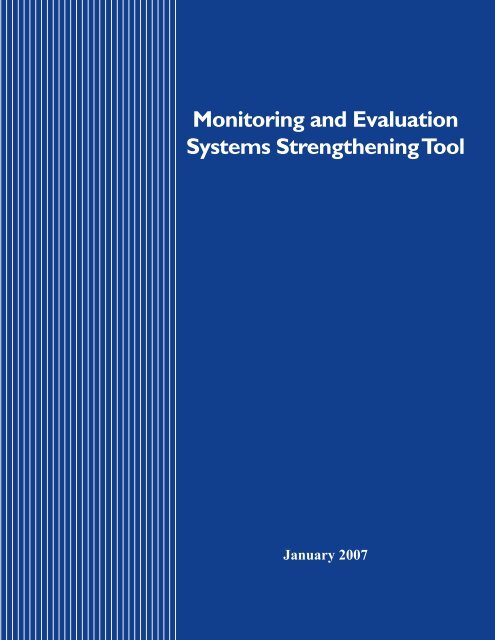


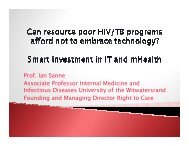
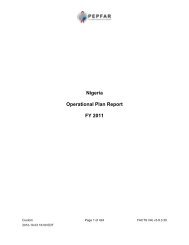

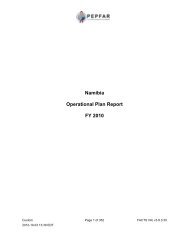
![PEPFAR Fiscal Year 2005 Operational Plan [pdf]](https://img.yumpu.com/25232699/1/190x245/pepfar-fiscal-year-2005-operational-plan-pdf.jpg?quality=85)
